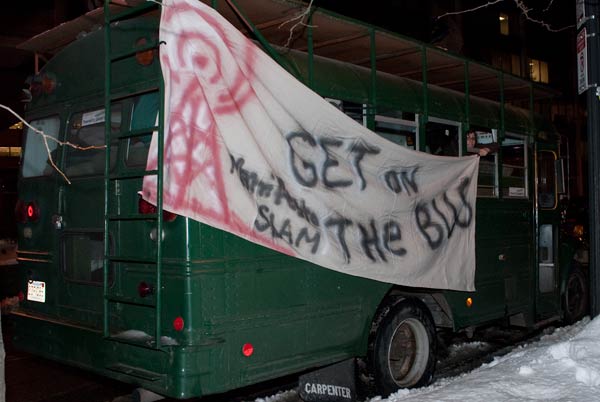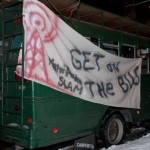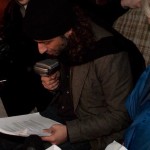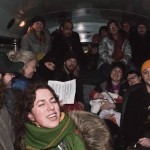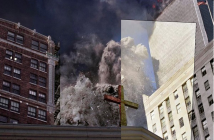PLATFORM2: MANIFESTO!SLAM
The banner said "Get on the bus" so we did, sixteen participants in the MANIFESTO!SLAM created by the social activist collaborative Platform2. It was a cold evening but everyone was jubilant, that morning having witnessed the inauguration of Barack Obama as 44th President of these United States. The MANIFESTO!SLAM was timed to deliver these manifestos, many many manifestos, to the new president and the renewed country on the day of the most significant transfer of power in many lifetimes.
The bus was green, fueled with bio-diesel. As it crept through Boston's snowy streets, those aboard took turns reading manifestos into a microphone. Their voices were broadcast through speakers to the passing sidewalks, a few chilly pedestrians looking up from the cold with questions on their faces. The Unabomber Manifesto, The Orgasm Manifesto, The DDIY (Don't Do It Yourself) Manifesto, The Maintenance Art Manifesto, The Universal Aliens Manifesto, and many more were read as the bus jolted along Newbury Street, across the bridge to Central Square, down though Allston and Kenmore Square, across Mass Ave and into the South End.
Sitting on the bus, hearing the manifestos and watching the pedestrians outside react, I had to wonder what the goal of the piece was. Is this a work of art at all, or just a bunch of art hippies annoying pedestrians? Why read such long and dense manifestos to people who will only hear a bit of them, or none at all? What is the experience of this work of art, why not call it social protest or an inauguration celebration or anything but art?
To understand the MANIFESTO!SLAM, I think it is important to look at the previous projects from Platform2. In each case, the projects were designed to provoke certain kinds of conversation, and through that dialogue pursue an artistic social agenda. Their Risk, Race, Class and Art event, for example, took attendees through Boston on the #1 bus route, passing through the extreme diversity of the communities along that route while discussing the complex issues of race and class in Boston. Along the way, people on the street engaged with the dialogue, sometimes shouting from cars as they passed, creating a cycle of community engagement and conversation. In the Failure Support Group, attendees each presented an instance of their own failure, and the conversation circled around the nature of process, the ideas of success and failure in contemporary art, and personal redemption. The Parade For the Future was created to deliberately force dialogue with the public, creating a spectacle on Boston Common designed to provoke questions from passersby and, in turn, spark discussion of global warming, rising sea levels and the precarious nature of Boston as a former island.
Thinking about MANIFESTO!SLAM in those terms, it becomes important to ask where the dialogue was created in the work. Who was the audience, or audiences, of this project and what kind of conversations were created?
This piece seems to me to have three audiences and no author, at least no single guiding authorial voice. It is an idea that, once set in motion, transcends any creator and takes on a life of its own. Each type of audience experience is different, dictated by that viewer's proximity to the idea and understanding of the nature of the underlying dialogue.
The first viewer group were the sixteen people on the bus. While ostensibly also authors of this piece, each person acted as audience to those around them. The goal of this work is to spark conversation, and the most concentrated conversations about the goals of broadcasting manifestos to the streets and sending them to the new president were contained in that bus during its short run.
The second viewer group were the people on the street, who heard snippets of manifestos as the bus passed. In one sense, this is the "true" audience for this work, but in another sense they are excluded from the larger meaning of the piece. While some passersby might have asked themselves or their friends what they had witnessed, without the underlying conceptual framework their understanding of their experience would have been incomplete. As viewers, they were not given enough context to understand the experience and make meaning of it, so as audience they were necessary to complete the piece but also excluded from fully participating in the work or its goal of creating dialogue.
The last audience group exists outside the work, in the form of those who heard about it and have engaged in conversation around the idea itself. In other words, the very nature of the piece, its underlying conceptual structure, exists independent of the piece. This isn't to say that the piece could have existed without the bus ride on Inauguration Day, but it does get the closest to the goal of Platform2's projects, which is to provoke conversation. Those who were not on the bus can, nevertheless, engage in discourse around the nature of the manifesto, the ways in which the weak communicate with the powerful, the very nature of how political ideas are transmitted, and many other facets of the piece without having to freeze on a January night.
As a work of art, the MANIFESTO!SLAM sits well among Platform2's other social engagement projects. Its goals transcend the experience of the bus ride (dare I call it a "performance"?) and ask questions about personal and community frameworks that might exist as manifestos. It creates a multiple-audience hierarchy in which those who might be expected to have the most direct engagement with the work - the participants and those who hear the manifestos from the sidewalk - are superseded by any and all who wish to consider and discuss the piece in the past-tense. It was a concept made manifest for one short hour, but only in service of larger and more complex goals. In other words, it was exactly what Platform2 does: art and social engagement.
- A green bio-diesel bus, packed with manifesto readers.
- Pirun (aka Sasha Rasovic) reads a manifesto
- A bus packed full of artists. Platform2 is in the foreground : Sasha Rasovic, Andi Sutton, Jane D. Marsching (with baby) and Catherine D’Ignazio
BIG_RED_ON-THE-TOWN_1103433_thumb.jpg) Click here to see more
Click here to see more
pictures from the
MANIFESTO!SLAM
"MANIFESTO!SLAM" occurred on Inauguration Day, January 20, 2009.
All images are courtesy of Platform2. Photos by James Manning.

